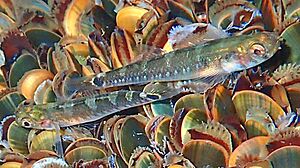Two-spotted goby facts for kids
Quick facts for kids Two-spotted goby |
|
|---|---|
 |
|
| Conservation status | |
| Scientific classification | |
| Synonyms | |
|
Genus
Species
|
The two-spotted goby (Pomatoschistus flavescens) is a small, interesting fish. It belongs to a group of fish called gobies. You can find these gobies living in the salty waters of the eastern Atlantic Ocean. They live from places like the Faeroes and Norway all the way down to the coast of Spain. They are also very common around the United Kingdom. These little fish usually grow to about 6 centimeters (about 2.4 inches) long.
Where the Two-Spotted Goby Lives
Two-spotted gobies love to live where there are lots of plants in the water. You can find them around structures covered in plants, or in thick beds of seaweeds like Laminaria (kelp) or Zostera (seagrass). They often live in tide pools, which are small pools of water left behind when the tide goes out. They also live in shallow ocean waters, usually no deeper than 20 meters (about 65 feet).
What the Two-Spotted Goby Looks Like
Pomatoschistus flavescens are small and thin fish. They can grow up to 6 centimeters long. One cool thing about them is that their eyes are on the sides of their head. Most other gobies have eyes on top of their head.
These gobies have a black spot near the base of their tail fin. Male gobies have a second, smaller black spot under their pectoral fins (the fins on their sides, like arms). Their bodies are usually reddish to greenish-brown. Their undersides are lighter in color. They have dark patterns on their backs. You might also see four light "saddle" marks across their back, from their head to the end of their second dorsal fin. Along the middle of their sides, they have a line of bluish marks. When it's time to breed, these blue marks become super bright on the males!
Life Cycle and Habits
Unlike many other gobies, the two-spotted goby does not usually live on the seabed. Instead, they swim together in groups, called shoals. They like to hang out among seagrasses and seaweeds. They eat tiny animals that float in the water, called zooplankton. This includes things like small crustacean larvae.
Breeding happens in the summer. During this time, the male goby becomes very protective of an area. He will defend a nest. This nest is usually a natural space, like an empty mussel shell or a folded kelp leaf. The male and female gobies do a special dance together to show they are ready to mate. The female then visits the nest and lays her eggs there. The male goby then takes care of the eggs. He guards them, cleans them, and fans them with his fins to keep them healthy. He might take care of eggs from one or even several females. The eggs will hatch after a while. After the young fish grow during the summer, they move into deeper water for the winter. Adult gobies usually die after they have reproduced once.


